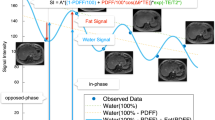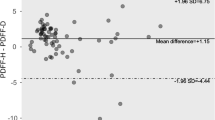Abstract
Non-alcoholic fatty liver disease (NAFLD) is a highly prevalent condition with a large impact on public health, but remains largely undetected among individual patients. MRI proton density fraction (MRI-PDFF) is the gold standard method for measuring liver fat content, but might be regarded as “overkill” for this diffuse liver disease process. There is a pressing current medical need for simpler non-invasive approaches to measure and track liver fat content over time, for which emerging unilateral permanent magnet MR technology is uniquely suited. In this study, we evaluate the potential of the barrel magnet system first described by Utsuzawa and Fukushima in 2017 to quantify liver fat content. We tested this novel unilateral MR system in oil–water emulsions and subsequently with ex vivo tissue samples from normal and fatty duck livers. In oil–water emulsions, the system provided good linear agreement between fat signal amplitudes derived from Bayesian analysis of MR signals and known oil content. Clear differences in water and fat signal amplitudes were also observed between normal and fatty liver samples. The ability to discriminate differences in fat content as little as 5% demonstrates clear potential clinical relevance for medical management of NAFLD using a scaled-up system designed for human studies.





Similar content being viewed by others
Data Availability
Raw data are available to interested parties on request.
References
P.B. Duell et al., Nonalcoholic fatty liver disease and cardiovascular risk: a scientific statement from the American Heart Association. Arterioscler. Thromb. Vasc. Biol. 42(6), e168–e185 (2022)
B.J. Perumpail et al., Clinical epidemiology and disease burden of nonalcoholic fatty liver disease. World J. Gastroenterol. 23(47), 8263–8276 (2017)
N.H. Bzowej, Nonalcoholic steatohepatitis: the new frontier for liver transplantation. Curr. Opin. Organ Transplant. 23(2), 169–174 (2018)
Y. Sumida et al., Phase 3 drug pipelines in the treatment of non-alcoholic steatohepatitis. Hepatol. Res. 49(11), 1256–1262 (2019)
A. Tang et al., Accuracy of MR imaging-estimated proton density fat fraction for classification of dichotomized histologic steatosis grades in nonalcoholic fatty liver disease. Radiology 274(2), 416–425 (2015)
C. Caussy et al., Noninvasive, quantitative assessment of liver fat by MRI-PDFF as an endpoint in NASH trials. Hepatology 68(2), 763–772 (2018)
C. Caussy, L. Johansson, Magnetic resonance-based biomarkers in nonalcoholic fatty liver disease and nonalcoholic steatohepatitis. Endocrinol. Diabetes Metab. 3(4), e00134 (2020)
O.W. Hamer et al., Fatty liver: imaging patterns and pitfalls. Radiographics 26(6), 1637–1653 (2006)
S.B. Reeder, C.B. Sirlin, Quantification of liver fat with magnetic resonance imaging. Magn. Reson. Imaging Clin. N. Am. 18(3), 337–57 (2010)
V. Capitan et al., Macroscopic heterogeneity of liver fat: an MR-based study in type-2 diabetic patients. Eur. Radiol. 22(10), 2161–2168 (2012)
Q. Li et al., Current status of imaging in nonalcoholic fatty liver disease. World J. Hepatol. 10(8), 530–542 (2018)
A. Bashyam et al., A portable single-sided magnetic-resonance sensor for the grading of liver steatosis and fibrosis. Nat. Biomed. Eng. 5(3), 240–251 (2021)
M. Barahman et al., Point-of-care magnetic resonance technology to measure liver fat: phantom and first-in-human pilot study. Magn. Reson. Med. 88(4), 1794–1805 (2022)
R.S. Lu et al., A novel portable unilateral magnetic resonance magnet for noninvasive quantification of human liver fat. IEEE Trans. Instrum. Meas. 72, 1–8 (2023)
S. Utsuzawa, E. Fukushima, Unilateral NMR with a barrel magnet. J. Magn. Reson. 282, 104–113 (2017)
J.A. Jackson, L.J. Burnett, J.F. Harmon, Remote (inside-out) Nmr. 3. Detection of nuclear magnetic-resonance in a remotely produced region of homogeneous magnetic-field. J. Magn. Reson. 41(3), 411–421 (1980)
M.S. Conradi, S.A. Altobelli, Spatial selectivity by shaping the static field: sweet spots and spider legs. Appl. Magn. Reson. (2023). https://doi.org/10.1007/s00723-023-01548-5
B. Blumich et al., The NMR-mouse: construction, excitation, and applications. Magn. Reson. Imaging 16(5–6), 479–484 (1998)
Stan Development Team. Stan modeling language users guide and reference manual. https://mc-stan.org (2023).
S.H. Baete et al., Microstructural analysis of foam by use of NMR R2 dispersion. J. Magn. Reson. 193(2), 286–296 (2008)
Y. Nakashima, Development of a single-sided nuclear magnetic resonance scanner for the in vivo quantification of live cattle marbling. Appl. Magn. Reson. 46(5), 593–606 (2015)
Y. Nakashima, Non-destructive quantification of lipid and water in fresh tuna meat by a single-sided nuclear magnetic resonance scanner. J. Aquat. Food Prod. Technol. 28(2), 241–252 (2019)
M.D. Hurlimann, Diffusion and relaxation effects in general stray field NMR experiments. J. Magn. Reson. 148(2), 367–378 (2001)
F. Balibanu et al., Nuclear magnetic resonance in inhomogeneous magnetic fields. J. Magn. Reson. 145(2), 246–258 (2000)
J.H. Ahn et al., Effect of hepatic steatosis on native T1 mapping of 3T magnetic resonance imaging in the assessment of T1 values for patients with non-alcoholic fatty liver disease. Magn. Reson. Imaging 80, 1–8 (2021)
D. Capitani et al., Portable NMR in food analysis. Chem. Biol. Technol. Agric. (2017). https://doi.org/10.1186/s40538-017-0100-1
T. Toro-Ramos et al., Reliability of the EchoMRI infants system for water and fat measurements in newborns. Obesity (Silver Spring) 25(9), 1577–1583 (2017)
G.Z. Taicher et al., Quantitative magnetic resonance (QMR) method for bone and whole-body-composition analysis. Anal. Bioanal. Chem. 377(6), 990–1002 (2003)
L.A. Colucci et al., Fluid assessment in dialysis patients by point-of-care magnetic relaxometry. Sci. Transl. Med. (2019). https://doi.org/10.1126/scitranslmed.aau1749
A. Bashir, R. Gropler, J. Ackerman, Absolute quantification of human liver phosphorus-containing metabolites in vivo using an inhomogeneous spoiling magnetic field gradient. PLoS One 10(12), e0143239 (2015)
V.O. Boer et al., Lipid suppression for brain MRI and MRSI by means of a dedicated crusher coil. Magn. Reson. Med. 73(6), 2062–2068 (2015)
W. Chen, J.J.H. Ackerman, Spatially-localized NMR spectroscopy employing an inhomogeneous surface-spoiling magnetic field gradient. 1. Phase coherence spoiling theory and gradient coil design. NMR Biomed. 3(4), 147–57 (1990)
D.G. Wiesler et al., Reduction of field of view in MRI using a surface-spoiling local gradient insert. J. Magn. Reson. Imaging 8(4), 981–988 (1998)
L.L. Wald et al., Low-cost and portable MRI. J. Magn. Reson. Imaging 52(3), 686–696 (2020)
R. Heiss et al., Low-field magnetic resonance imaging: a new generation of breakthrough technology in clinical imaging. Investig. Radiol. 56(11), 726–733 (2021)
P.C. McDaniel et al., The MR cap: a single-sided MRI system designed for potential point-of-care limited field-of-view brain imaging. Magn. Reson. Med. 82(5), 1946–1960 (2019)
P. Satya et al., Office-based, single-sided, low-field MRI-guided prostate biopsy. Cureus 14(5), e25021 (2022)
Funding
N/A.
Ethics declarations
Conflict of Interest
Dr. Conradi is an employee of ABQMR, Inc.
Ethical Approval
N/A.
Additional information
Publisher's Note
Springer Nature remains neutral with regard to jurisdictional claims in published maps and institutional affiliations.
Prepared for Applied Magnetic Resonance issue on the occasion of Bernhard Blümich’s 70th birthday.
Supplementary Information
Below is the link to the electronic supplementary material.
Rights and permissions
Springer Nature or its licensor (e.g. a society or other partner) holds exclusive rights to this article under a publishing agreement with the author(s) or other rightsholder(s); author self-archiving of the accepted manuscript version of this article is solely governed by the terms of such publishing agreement and applicable law.
About this article
Cite this article
von Morze, C., Blazey, T. & Conradi, M.S. Quantifying Liver Fat Using a Low-Field Unilateral MR System. Appl Magn Reson 54, 1365–1376 (2023). https://doi.org/10.1007/s00723-023-01595-y
Received:
Revised:
Accepted:
Published:
Issue Date:
DOI: https://doi.org/10.1007/s00723-023-01595-y




